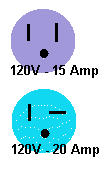| Main Power Requirements, 115V Installation | Previous Page | 230 Volt Requirements |
|
FIRST! Regardless of what you hear on a sales floor
regarding power requirements, MOST of these spas will require a dedicated outlet rated at 115 Volts
at 20 Amps, with its own circuit breaker.
If you're not sure, or cannot get a straight answer,
then look at the spa plug itself. If the prongs on it look like a standard plug, then
okay, it's a 15 Amp maximum rated
plug-in. Second, do not twist the sideways prong vertically to plug it into a standard outlet! There's a good reason the 115 Volt / 20 Amp circuit is made this way. It's designed to ensure that the outlet is serviced to a 20 Amp capacity, to prevent circuit overloading, wire overheating, and potential hazards for electrical fire! Additionally, by having a dedicated 20 Amp outlet for the spa, you will prevent voltage drops for other lights and appliances on the circuit, and inadvertent circuit breaker tripping from short term overloads, such as during pump motor start-up. Most outlets that are mounted for outside usage on a home are rated at only 15 Amps, are connected to other outlets or lighting circuits, and are unsafe to use. Convinced about that 20 Amp circuit yet? No, well try this: After three years of being plugged into the same outlet, that 15 Amp circuit breaker just won't stay on anymore. Now you've got to call an electrician ($95 service call), and replace the breaker (he'll probably charge $25 or more for it). Still No? Are you sure that the spa circuit that you've "rigged" to work isn't connected to anything else? Do you really want the voltage variations, ie drops and spikes, not to mention the radio frequency noise from relay actuations and such, that come from a spa connected directly to the same circuit.... as that $2500 home theatre you just bought? So, be safe folks, do it right the first time! |
 However, if one of the prongs is sideways, instead of vertical, then it definitely is a 20 Amp
rated plug, and REQUIRES a dedicated circuit for it to operate safely and
efficiently.
However, if one of the prongs is sideways, instead of vertical, then it definitely is a 20 Amp
rated plug, and REQUIRES a dedicated circuit for it to operate safely and
efficiently.